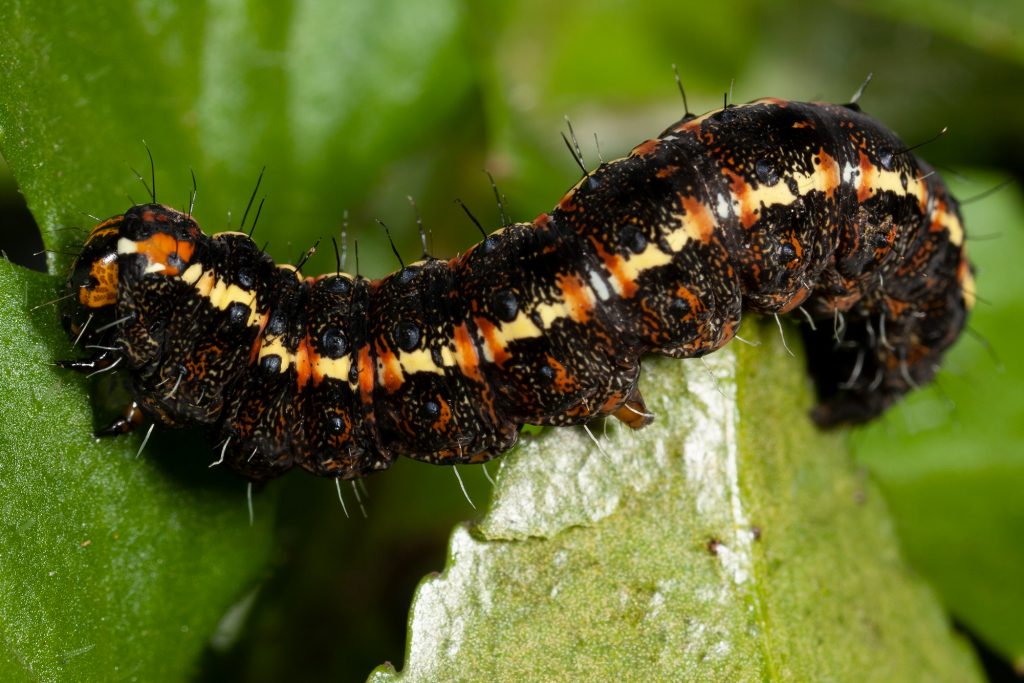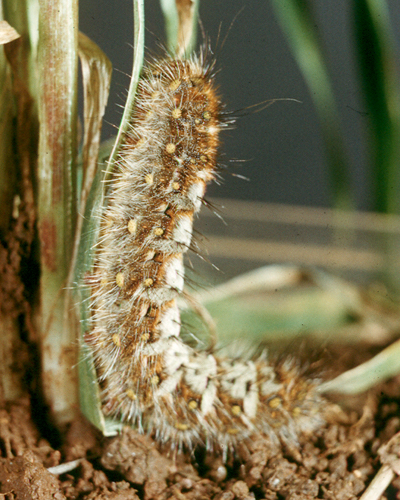There are plenty of armyworms about, but it’s also been an active season for other caterpillar pests as well.
Where have they been reported?
More caterpillars, mostly ‘herringbone caterpillars’ (Proteuxoa sp. in the family Noctuidae), but also brown pasture loopers (Ciampa arietaria), pasture day moth (Apina callisto) and grass anthelids (Pterolocera spp.) have been found damaging crops in the Victorian Mallee, Wimmera and the NSW Riverina.
‘Herringbone caterpillars’ and brown pasture loopers have caused major damage to lentils in a trial site just south of Horsham in the Victorian Wimmera. These caterpillars were found during the day feeding on the crop as well as curled up under clods of soil. They had completely severed many of the lentil plants at the base, as well as some branches, leaving them strewn on the ground. It is possible that wheat stubble from last year’s crop may have provided a site for female moths to lay their eggs, as is the case with armyworms.
These ‘herringbone caterpillars’ have also been found damaging a wheat crop near Deniliquin in the NSW Riverina, as well as peas, beans and lentils at a trial site southwest of Sea Lake in the Victorian Mallee. In the wheat crop, the damage occurred in large patches where last year’s stubble was present. In the peas, beans and lentils the caterpillars were not in high numbers but were found chewing some of the lower leaves of plants.
Additional reports of herringbone caterpillars have come from several barley crops, near Manangatang, also in the Mallee. The feeding damage in these crops has not warranted control.
Pasture day moth caterpillars have been chewing leaves to a varying extent on a stand of dryland lucerne near Elmore in Victoria’s Northern Country, with numbers of approximately 5-10/m2 in patches that required spraying. Pasture day moths have also been reported from the Victorian Wimmera.
Grass anthelid caterpillars, also known as ‘woolly bear caterpillars’, have been found chewing on leaves of cereal and lentil crops in low numbers just north of Swan Hill and around Manangatang, in the Victorian Mallee.


About these caterpillars
There is little known about the biology of the ‘herringbone caterpillars’ that are causing widespread damage this season; in fact there is not even a common name for the pest. (Hence we have resorted to referring to the distinctive ‘herringbone’ marking on their backs that is characteristic of many of the 70+ species in this genus.) It appears as if the common pest that we have been observing this year is P. atrisquamata. This species has a distinctively lighter final abdominal segment. The genus Proteuxoa is currently undergoing a major taxonomic revision and in time this will bring more clarity.
For comprehensive information on brown pasture loopers, pasture day moths or grass anthelids, including their occurrence, lifecycle, behavior and management strategies, go to brown pasture looper, pasture day moth or grass anthelid within the new PestNote series.


Our advice
Ensure correct identification of caterpillars before deciding on the most appropriate management action required. The use of insecticides in winter to control caterpillars will also risk eliminating the beneficials that, in many cases, moderate aphid and caterpillar populations. The loss of beneficials can often induce earlier or secondary pest outbreaks.
Acknowledgements
Sources of field reports
Jason Brand – Senior Research Agronomist, Vic DEDJTR (Victorian Mallee)
Chris Dunn – Agronomist, Landmark (Victoria’s Northern Country)
Rob Launder – Consultant, AgriTech Rural (Victorian Wimmera)
Simon Mock – Consultant, Clovercrest consulting (Victorian Wimmera)
Andrew McMahen – Agronomist, Landmark (Victorian Mallee)
Matt Witney – Consultant, Dodgshun Medlin consultants (Victorian Mallee)
Justin Whittakers – Agronomist, Landmark (NSW Riverina)
Cover image: Photo by Andrew Weeks, Cesar Australia





